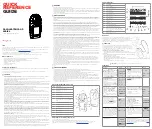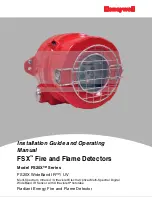
8
17
THE BASICS OF METAL DETECTING
A hobby metal detector is intended for locating buried metal objects. When
searching for metals, underground or on the surface, you have the following
challenges and objectives:
1. Ignoring signals caused by ground minerals.
2. Ignoring signals caused by metal objects that you do not want to find, like
pull-tabs.
3. Identifying a buried metal object before you dig it up.
4. Estimating the size and depth of objects, to facilitate digging them up.
5. Eliminating the effects of electromagnetic interference from other
electronic devices.
Your Gamma 6000 metal detector is designed with these things in mind.
1. Ground Minerals
All soils contain minerals. Signals from ground minerals can interfere with
the signals from metal objects you want to find. All soils differ, and can
differ greatly, in the type and amount of ground minerals present. You
therefore want to “calibrate” the detector to the specific ground conditions
where you are hunting. The detector incorporates a semi-automated
ground-balancing feature which will eliminate false signals from most types
of soils. But if you want to maximize the detector’s target identification
accuracy and depth of detection, use the GROUND GRAB function to
calibrate the detector to the ground where you are searching. See the
section on GROUND GRAB for details.
2. Trash
If searching for coins, which will induce higher tone sounds, you want to
ignore items like aluminum foil, nails, and pull-tabs. These undesirable
items induce lower tones. You can listen to the sounds of all objects
detected, and decide on what you want to dig up. Or you can eliminate
unwanted metals from detection by using the DISCRIMINATION feature.
3. Identifying Buried Objects
When searching in the DISCRIMINATION mode, different objects induce
different tones (high, medium, low) and are classified on the display screen
in different categories from left to right. A 2-digit numerical reading is also
provided in the middle of the display for more precise target identification.
The DISCRIMINATION mode requires motion: sweep the coil over the
metal object.
OPERATION and CONTROLS
cont.
GROUND BALANCING
4. GROUND GRAB
All soils contain minerals. Signals from ground minerals interfere with the
signals from metal objects. All soils differ, and can differ greatly, in the type and
amount of ground minerals present. This detector incorporates ground
balancing algorithms which eliminate interference caused by the ground
minerals found in most soils.
The GROUND GRAB and MANUAL GROUND balancing feature allows the
user to more precisely calibrate the detector’s internal circuitry to the specific
ground you are searching.
We therefore recommend that you use GROUND GRAB to most accurately
calibrate the detector to the specific ground conditions where you are hunting. It is
a quick and automated process, and will instantly grab the ground reading of any
patch of ground you are standing over. This process will maximize the detector’s
target identification accuracy and depth detection capability.
AUTOMATIC GROUND BALANCING PROCEDURE USING GROUND GRAB
1. Find a spot of ground where there is no metal present.
2. Hold the detector with the searchcoil about one foot
above the ground.
3. Enter the GROUND GRAB mode.
3. Push and hold
.
4. Physically pump the searchcoil and detector up and
down over the ground.
Lift it about 6 inches above the ground and lower it to within
1 inch of the ground, about once or twice a second.
5. A 2-digit ground value will appear on the display. This is the
Ground Balance setting.
6. When the 2-digit ground value stabilizes, release the button.
Note:
GROUND GRAB will not automatically balance over highly conduc-
tive soils, such as a wet salt water beach. Automatic balancing is not possi-
ble in soils with gound values less than 40. The screen will display “--” and
an alarm will sound if over metal or in ground with a value less than 40.
MANUAL GROUND BALANCING
In most situations, it is preferable to use GROUND GRAB to automatically
ground balance. Generally, it is best to first let the detector automatically
cancel interference from ground minerals. However, for gold prospecting,
searching on a wet saltwater beach, or searching in an area with so much
metal trash that there is no clean ground for the detector’s internal computer
to sample, we recommended that you manually ground balance. Manual
ground balancing requires a bit of skill, acquired with some practice.








































